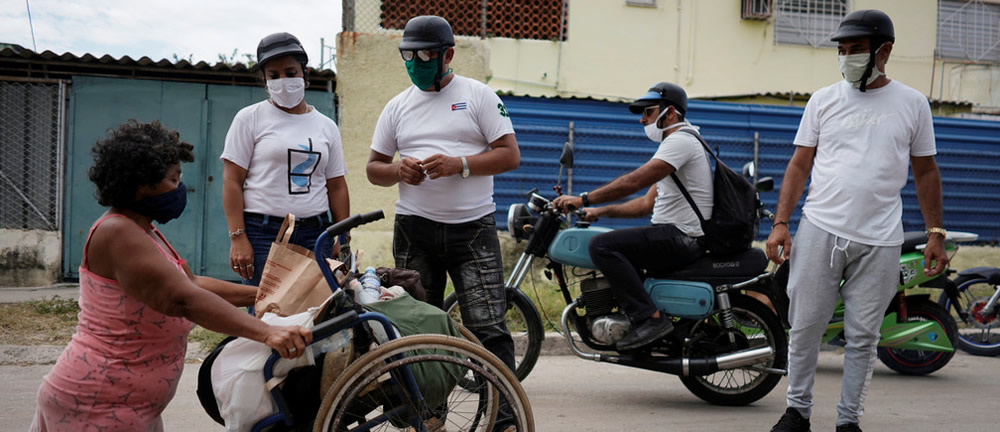 • The 1.3 billion living with disabilities worldwide are no stranger to the kind of exclusion the coronavirus has forced on the rest of the population.
• The 1.3 billion living with disabilities worldwide are no stranger to the kind of exclusion the coronavirus has forced on the rest of the population.
• The shift in working practices proves that similar adaptations could be made for those with disabilities.
• The ‘inclusion revolution’ has a strong business imperative, but an even stronger moral one.
Around the world, governments are placing their citizens into various forms of lockdown as the COVID-19 virus takes an increasingly tight hold on the global population.
Suddenly, and for the first time in a very long time, huge populations are coming face to face with a feeling of exclusion from normal life and a sense of isolation, as individuals with the virus, and those in their households, are quarantined in homes and hospitals.
But for many people, this sense of isolation and detachment from “normal” life isn’t a temporary phase; they aren’t waiting out the lockdown for normality to resume. For a large percentage of the population, including the elderly and many of the 1.3 billion people living with a disability worldwide, this daily experience of isolation and exclusion is unfortunately the norm.
Many of those living with a disability will not be able to go back to “business as usual” after the pandemic has cleared: This is their usual. But their usual must change with this pandemic, because for far too long, people living with a disability have been excluded from daily life.
The proof points have been around for a long time: We know people of working age with disabilities have an employment rate that is 28.6 percentage points lower than that of people without disabilities, and only 4% of businesses focus on making offerings that are inclusive of disability. Yet disability exclusion costs OECD countries 7% of their GDP, and disabled people, together with friends and family, wield a spending power of $8 trillion.
What we’re seeing today is business at its most agile: Responding rapidly and flexibly to the impact of the virus and taking immediate actions to protect employees and customers alike. We’ve seen the swift implementation of widespread home working, dedicated shopping hours for the vulnerable, and a huge upswing in the use of virtual conferencing technology.
The worldwide shift in business practices we’ve seen in the last month has answered a fundamental question for many companies: Can my business not only adapt, but thrive when most of my staff are working from home? For most companies, the answer is yes. Knowing that this can work has huge implications for the inclusion of people with disabilities in business, as many of the practices we’ve seen so quickly drafted in over the last month are the same ones that allow those with disabilities to not only participate, but to thrive, in business.
We must ensure businesses apply the learnings from this period to improve inclusion of people with disabilities worldwide by using the same tools we’re using now to allow this community to participate fully in the workforce. There’s no excuse not to – we’ve seen it work for a large part of the 7.8bn global population; now it needs to continue to work for the 1.3bn.
What’s more, the coronavirus pandemic has brought into sharp focus the critical importance of digital communication for businesses to run smoothly during this period, and its importance in allowing those staying at home to remain connected with friends and family, deterring loneliness. The value we see in digital communications must apply to people with disabilities, too. We must ensure going forward that websites and digital media are fully accessible, and that captioning and audio description become the norm, not the exception, so that people with disabilities can enjoy the very same benefits we’re experiencing right now.
We already know businesses are missing out on huge opportunities to reach audiences, due to lack of accessibility. In 2016, the UK’s Click-Away Pound survey found that more than 4 million people abandoned a retail website because of the barriers they found, taking with them an estimated spend of £11.75 billion. In 2019, that lost business has grown to £17.1 billion. It makes hard business sense to change this, and now is the time to do so.
What I call the “inclusion revolution” has been gaining more and more momentum over the last few years, as global companies wake up to the moral, social and economic benefits of including people with disabilities. Indeed, since launching The Valuable 500 – the global movement calling on 500 national and multinational, private-sector corporations to put disability on the business leadership agenda – on stage at the World Economic Forum in 2019, 260 of the world’s leading CEOs and global brands have joined the campaign. These companies are the tipping point for change and have come together to unlock the widespread business, social and economic value of people living with disabilities across the world.
We have an opportunity now to speed up momentum on the issue, build on the learnings from these last few weeks, and create new world systems that include people with disabilities. We have to better recognize the value of everyone so that no one is left behind – and make sure inclusion for everyone is “baked in”, rather than the exception.
We didn’t think our world systems could change, and yet we have proved that they can during this crisis – there are no excuses not to change in the future. We must now redesign the system again post-COVID-19, to create full inclusion from the very outset.
Source: weforum.org






